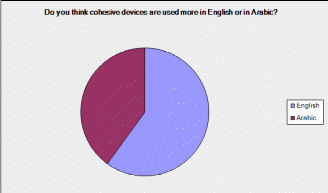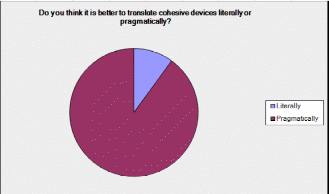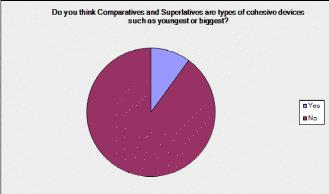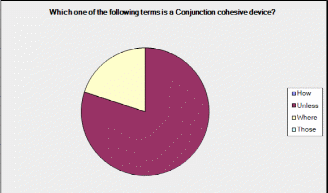The following research paper is designed to touch upon the subject of cohesive devices and their general effect on the process of translation. Quantitative methods and survey piloted by the researcher distributed to a group of ten students who are quite informed on the use of these cohesive devices as they apply those in English and Arabic. This group of respondents each is having an experience of not less than three years of dealing with English Arabic translations and their implementation in practice.
The results showed that most students found that the use of cohesive devices was more frequent in English than in Arabic. The following pages will highlight some of the facts collected from representatives of this group. The research was limited to the study of the written translations of cohesive devices in English and Arabic languages.
Introduction
A cohesive device is a lexeme or more the function of which is to introduce an idea or to link it with another one in a text. Cohesive devices can be grammatical and/or lexical. Different types of cohesive devices are used for different functions. The aim of this study is to show the difference in using cohesive devices between English and Arabic translations.
In general, a cohesive device in one language can have several equivalents in other ones. The use of ‘Wa’ (and) in Arabic language, for instance, is matched in English, by no means. The following example has been translated literally from standard Arabic: هو غادر سيدني ويسقط المطر بشدة – He left Sydney and the rain falls heavily.
The intended meaning of and is certainly not the same as the English and. The function of Arabic and in this context is more like that of temporal adverb in English. In other words, a better equivalent in English is while (O’Regan, 2002).
Cohesive devices can be used not only as adverbs of place or time as mentioned above, but also as the following parts of speech: 1) demonstratives, such as (this, these; that, those); 2) comparative and superlative degrees of adjectives, such as (young, younger, youngest); 3) conjunctions, mainly expressed by conjunctions, such as (and, but, yet, etc.), according to Gutt (as cited in Baker & Saldanha, 2008, p. ) who focused on the relevance of the translation with regard to the appropriateness of means used to render the meaning of the original text into the text in a target language.
However, this research is designed to analyse my hypothesis that cohesive devices are more frequently used in English than Arabic. My research question in this context concerns the reasons for using cohesive devices in English is more frequent than Arabic. The research is based on the primary sources, suchlike a survey containing the answers of students; however, the research of secondary sources was conducted as well in order to learn more about the formal ways of translation, the use of electronic means, and irrelevance of translation methods to the context of the original message. It is important to analyse the degree of understanding the cohesive devices as they appear and the ability to implement those while translating and arguing on the use of appropriate devices.
Methodology
The main question concerns the level of usage of cohesive devices in Arabic and in English. I was going to conduct this research with the help of the questionnaire, its results, and analysis of what I have found out via asking overseas students knowledgeable in Arabic language and comparing and contrasting the data I have collected with similar researches and findings in this area.
A research study was conducted within a group of students consisting of ten people that came from Arabic countries and know Arabic language; they are studying in Australia at the University of Western Sydney. It turned out that all students taking part in the research have been studying English fro five to seven years and even more. The questionnaire was designed by the researcher; it consists of ten questions divided into three sections.
Firstly, personal information that included the age, gender, and experience in English language acquisition that stood between three to more than seven years of studying English. Secondly, translation questions those were supposed to clarify the relevance of the research to the level of the language acquisition by overseas students and their ability to put theoretical knowledge into practice. Finally, multiple choice questions were aimed at giving students an opportunity to change their mind and give an alternative opinion on the use of cohesive devices while translating from Arabic into English and vice versa.
During the process of answering the questionnaire the participants of the survey were free to ask questions for further clarification if they found some issue not clear enough. The respondents had to fill in the questionnaire and return it to the researcher. The data was analysed and studied by the researcher. The secondary research showed that some cohesive devices are used in Arabic language more often than in English, thus the study presented by Hinkel (2002) demonstrates a high level of use of demonstratives as cohesive devices by people speaking Arabic language; whereas English academic language is supposed to avoid excessive use of demonstratives (p. 155).
Results and Discussion
The results of the research have supported my hypothesis concerning the correlation of cohesive devices used in English while translating from Arabic and vice versa. It is important to mention that the research included data from primary sources and secondary sources correspondingly. Thus, the primary research was aimed at finding out the degree of understanding the concept of cohesive devices and their use while translating from Arabic into English and vice versa.
Figure 1 contains the percentage ratio of cohesive means used in Arabic and in English languages. The participants of the research did not have a single idea; this is why the results present 60% of respondents claiming that English uses more cohesive devices and the rest of respondents (40%) believe that Arabic language contains more cohesive devices.

Figure 2 addresses the way the cohesive devices should be rendered from the source language into the target language while translating. The results show that only 10% of respondents think that it is better to translate the cohesive device literally than pragmatically. This fact contributes greatly to the diversity between linguists that explore on the theoretical side of languages and overseas students that came from Arabic countries and study in Australia.

The expected findings were supported by the survey, whereas the existing data on the way of rendering the cohesive devices into target language vary greatly. Amos (2008) suggests the idea that the results of the translation and the means chosen for translation of this or that lexical units or semantic units should be adequately selected by the translator (p. 31). Baker & Saldanha (2008) claim that the degree of use of cohesive devices depends on the nature of the target language compared with the source language while translating a text (p. 105).
Figure 3 represents the knowledge of the respondents in terms of cohesive devices and their variety in the English language. Thus, only ten percent of the respondents know that comparative and superlative degrees of adjectives are considered to be cohesive devices. Moreover, pronouns, demonstratives, adverbs of place and time, conjunctions, and other parts of speech can perform the function of cohesive devices.

This figure shows that the knowledge acquired by students is not sufficient to judge upon the relevance of the translation and adequate use of the cohesive means. If a person cannot recognise a cohesive device, he/she is not able to give an adequate answer on the question about the appropriateness of use of a cohesive device.
Figure 4 demonstrates the level of awareness of the respondents on the cohesive devices, their types, and relevance of use. As you can see, it is necessary to develop the students’ knowledge on the cohesive devices used in while performing written translations with regard to Arabic and English languages. No one recognised the demonstrative those as one of the most disputable and spread cohesive devices used while translating from English to Arabic and vice versa.

Different types of written translations as well as those using different software programs should be analysed to understand the difference between interpreted and translated texts. Muegge (2005) argues on the formal documentation that should be completed while having some written messages translated in the written form (contracts and orders should be organised properly not to be misled by inappropriate translation); use of specific electronic means of translation are discussed by the author as well.
Kelly (1979) claimed that the message is rendered from one language to another with regard to peculiarities of both languages. It is also necessary to emphasise that peculiarities of the Arabic language have been successfully described by Wright (1896).
Conclusion
Though the research helped to indicate some differences between the scholarly views and the opinion of the respondents of the survey conducted among the overseas students, it appeared to be very interesting to investigate the theoretical issues with the ones put in practice by students speaking the Arabic language. To conclude, it is recommended that other researchers can do a survey targeting all overseas students from all universities in Sydney or Australia.
The results of a massive survey will be more reliable because the current survey was based on the opinion and knowledge collected from ten students, whereas a survey based on about twenty respondents’ views can give a more objective picture. As you can see, the results turned out to differ from the ones introduced by linguists who studied the peculiarities of both languages and are more knowledgeable in terms of practical translation and more appropriate means of rendering the meaning of the source text into the target language.
References
- Amos, F. R. (2008). Early theories of translation. London: BiblioBazaar, LLC.
- Baker, M., & Saldanha, G. 2008. Routledge encyclopedia of translation studies. London: Routledge.
- Hinkel, A. (2002). Second language writers’ text: linguistic and rhetorical features. London: Routledge.
- Kelly, L. G. (1979). The true interpreter: a history of translation theory and practice in the west. New York: St. Martin’s Press.
- Muegge, U. (2005). Translation contract: a standards-based model solution. Bloomington, Indiana: AuthorHouse.
- O’Regan, D. (2002). Cohesion. Web.
- Wright, W. (1896). A grammar of the Arabic language. London: BiblioBazaar.